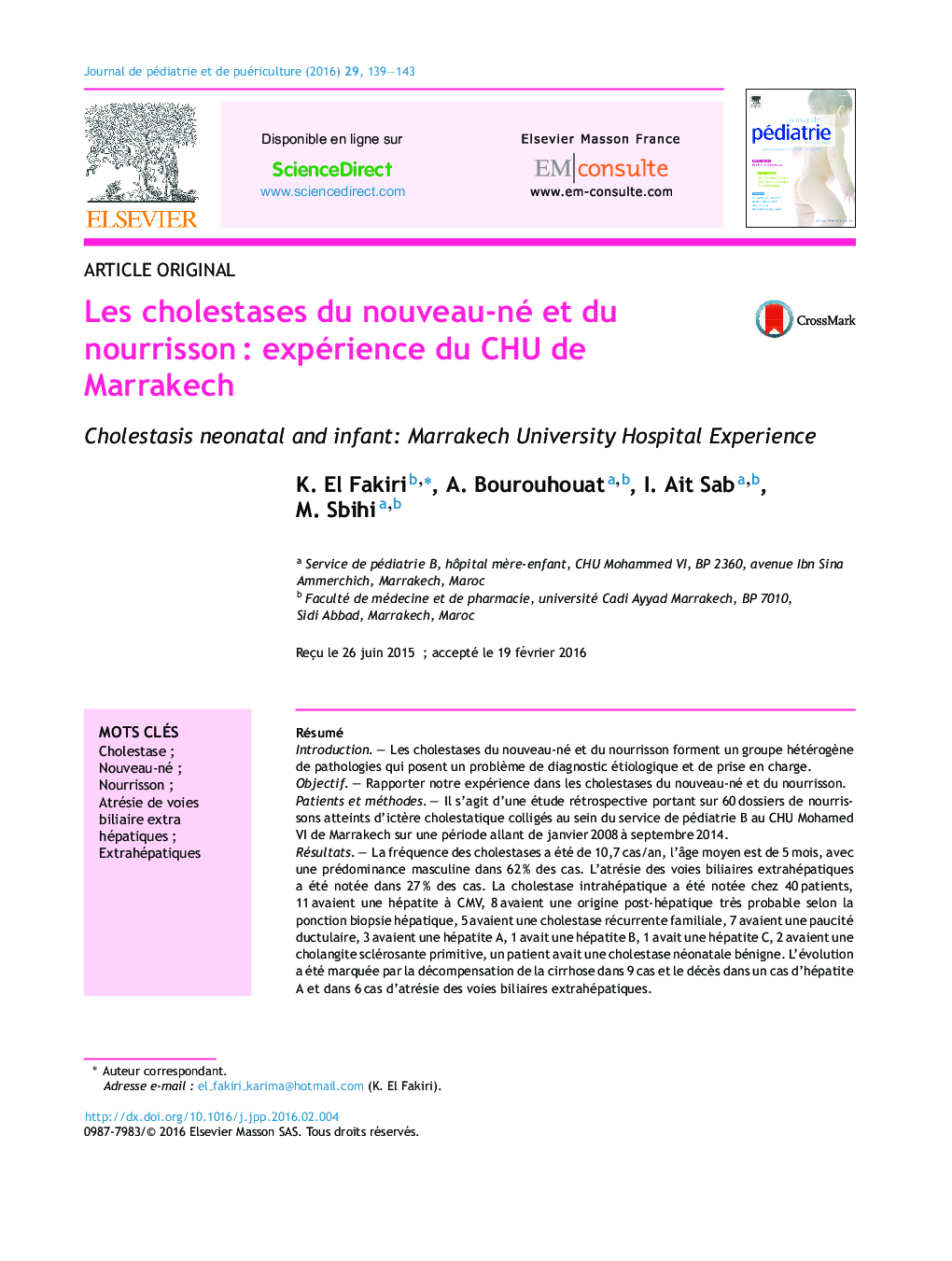| کد مقاله | کد نشریه | سال انتشار | مقاله انگلیسی | نسخه تمام متن |
|---|---|---|---|---|
| 4169660 | 1275410 | 2016 | 5 صفحه PDF | دانلود رایگان |

RésuméIntroductionLes cholestases du nouveau-né et du nourrisson forment un groupe hétérogène de pathologies qui posent un problème de diagnostic étiologique et de prise en charge.ObjectifRapporter notre expérience dans les cholestases du nouveau-né et du nourrisson.Patients et méthodesIl s’agit d’une étude rétrospective portant sur 60 dossiers de nourrissons atteints d’ictère cholestatique colligés au sein du service de pédiatrie B au CHU Mohamed VI de Marrakech sur une période allant de janvier 2008 à septembre 2014.RésultatsLa fréquence des cholestases a été de 10,7 cas/an, l’âge moyen est de 5 mois, avec une prédominance masculine dans 62 % des cas. L’atrésie des voies biliaires extrahépatiques a été notée dans 27 % des cas. La cholestase intrahépatique a été notée chez 40 patients, 11 avaient une hépatite à CMV, 8 avaient une origine post-hépatique très probable selon la ponction biopsie hépatique, 5 avaient une cholestase récurrente familiale, 7 avaient une paucité ductulaire, 3 avaient une hépatite A, 1 avait une hépatite B, 1 avait une hépatite C, 2 avaient une cholangite sclérosante primitive, un patient avait une cholestase néonatale bénigne. L’évolution a été marquée par la décompensation de la cirrhose dans 9 cas et le décès dans un cas d’hépatite A et dans 6 cas d’atrésie des voies biliaires extrahépatiques.ConclusionLe diagnostic étiologique de cholestase est une urgence surtout chez le nourrisson afin de dépister et traiter précocement les atrésies des voies biliaires fréquente dans notre contexte.
SummaryIntroductionCholestasis and the newborn infant are a heterogeneous group of diseases that pose a problem etiologic diagnosis and management.ObjectiveReport our experience in cholestasis in newborns and infants.Patients and methodsThis is a retrospective study of 60 cases of infants with cholestatic jaundice collected in the pediatric ward of the University Hospital of Marrakech Mohamed VI over a period from January 2008 to September 2014.ResultsThe frequency of cholestasis was 10.7 cases/year, the average age was 5 months (17 days–2 years), and the peak frequency was noted at 2 months with a male predominance (61.6%) and inbreeding in 40% of cases. Cholestasis was total and permanent in 60% of cases. A laboratory test was disrupted in all cases showing a very significant cytolysis in 33% of cases, a biological cholestasis with normal GGT in 4 cases. Abdominal ultrasound showed absence of visualization of the gall bladder in 14.5% of cases, liver cirrhosis with portal hypertension 14.5% of cases, a nodular likely post-hepatitic in 7.3%. The urine culture was positive dans15% of cases. Liver biopsy was performed in 28 patients. Following these investigations, the extrahepatic biliary atresia was noted in 27%. The intrahepatic cholestasis was observed in 40 patients, 11 had hepatitis CMV, 8 had an original post-hepatitic very likely according to puncture liver biopsy, 5 had a familial cholestasis recurrent 7 showed a paucity ductular, 3 had a hepatitis A, 1 had a hepatitis B, hepatitis C was 1, 2 had a primary sclerosing cholangitis, a patient had a benign neonatal cholestasis. The evolution was marked by decompensation of cirrhosis in 9 cases and death in a case of hepatitis A in 6 cases of atresia of extrahepatic biliary four through liver failure and two following to postoperative complications.ConclusionThe diagnosis of cholestasis is an emergency especially in infants to detect and surgically treat biliary atresia in common in our context. The poor prognosis of cholestasis is in part due to the delay of diagnosis and the difficulties of medical and surgical care.
Journal: Journal de Pédiatrie et de Puériculture - Volume 29, Issue 3, June 2016, Pages 139–143